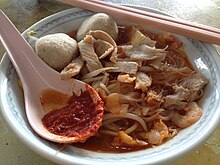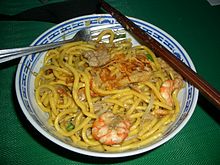Hokkien mee
This article needs additional citations for verification. (November 2015) |
 | |
| Type | Noodle |
|---|---|
| Place of origin | Malaysia and Singapore |
| Main ingredients | Egg noodles, rice noodles, egg, pork, prawn, squid |
| Variations | Hokkien hae mee, Hokkien char mee |
| Hokkien mee | |||||||
|---|---|---|---|---|---|---|---|
| Traditional Chinese | 福建麵 | ||||||
| Simplified Chinese | 福建面 | ||||||
| Hokkien POJ | Hok-kiàn mī | ||||||
| Literal meaning | Hokkien noodles | ||||||
| |||||||
Hokkien mee is a dish in Malaysian and Singaporean cuisine that has its origins in the cuisine of China's Fujian (Hokkien) province. In its most common form, the dish consists of egg noodles and rice noodles stir-fried with egg, slices of pork, prawns and squid, and served and garnished with vegetables, small pieces of lard, sambal sauce and lime (for adding the lime juice to the dish).
Types
There are three distinct types of Hokkien mee, with each being ubiquitous in specific localities in Singapore and Malaysia.
| Type | Penang hae mee (prawn noodles) | Singapore hae mee (prawn noodles) |
Hokkien char mee (fried noodles) |
|---|---|---|---|
| Origin | Penang | Singapore | Kuala Lumpur |
| Cooking method | Broth-based | Stir fried | |
| Ingredients | Egg noodles and rice noodles | Fat yellow noodles | |
| No dark soya sauce used | Dark soya sauce is used | ||
| Prawn is the main ingredient, with slices of chicken or pork, squid, fish cakes, kangkung and sambal added as well. | Prawn is the main ingredient with slices of chicken or pork, squid and fish cake. | Slices of chicken or pork, squid and cabbage | |
While both the Penang and Singapore versions are commonly known as hae mee (福建蝦麵), and consist of prawns as their main ingredients, the two variants are prepared differently. The Singapore hae mee is stir fried and has a lighter colour, while the Penang variant is cooked in a prawn-based spicy broth.
On the other hand, Hokkien char mee, which is more common in central Peninsular Malaysia and particularly the Klang Valley, was originally developed in Kuala Lumpur. By default in the Klang Valley, the term Hokkien mee refers to this darker, stir fried variant. The Penang variant is sometimes referred to as mee yoke.
Hae mee

Penang Hokkien mee
The Penang variant can be easily distinguished from the other variants by its characteristic spicy prawn broth. It primarily consists of rice vermicelli and thicker yellow egg noodles, while the broth is made with prawn heads and shells, and pork ribs.[1] Sliced prawns are also added into the dish, along with pork slices, hard boiled eggs, kangkung (Ipomoea aquatica), bean sprouts, fried shallots, lard and sambal. In Penang, pig skin, an ingredient rarely served in Kuala Lumpur, is a common topping as well.
In local parlance, Penang Hokkien mee is known by Penangites simply as Hokkien mee, while the Kuala Lumpur stir fried variant is called Hokkien char. Penang Hokkien mee is particularly ubiquitous in Penang, as it is served by hawker stalls and kopitiams (traditional Chinese coffee shops) throughout the state.
Singapore Hokkien Mee

The Singaporean version of Hokkien mee was created after World War II by Chinese sailors from Fujian (Hokkien) province in southern China. After working in the factories, they would congregate along Rochor Road and fry excess noodles from the noodle factories over a charcoal stove. Today, this dish, as served in Singapore and neighbouring Malaysian state of Johor, is a stir-fried dish of egg noodles and rice noodles in a fragrant stock. A flavourful stock is essential for a great tasting dish, and is usually made from stewing prawn heads, meat, clams and dried fish.
It is most commonly garnished with prawns, fish cake, pork ribs, squid, spring onions or chives. Traditionally, small cubes of fried lard are added, but this is now less common and have been substituted with chicken lard due to health concerns. Certified Halal Hokkien mee uses chicken and consists of no pork or pork lard, allowing it to be enjoyed by the Muslim community. Sambal chilli and lime are also standard toppings for this dish, giving it an extra zing and tanginess. Some stalls also serve the dish on an Opei leaf (soft palm bark), which enhances the fragrance of the dish.
Another version also referenced as prawn noodles in Singapore is similar to the Penang variation of Hokkien Mee. Egg noodles and rice noodles are served in richly flavoured dark soup stock with prawns, pork slices, fish cake slices, and bean sprouts topped with fried shallots and spring onion. The stock is made using dried shrimps, prawn heads, white pepper, garlic and other spices.
Hokkien Char Mee
Hokkien char mee (Hokkien fried noodles; 福建炒麵) is served in Kuala Lumpur and the surrounding region. It is a dish of thick yellow noodles braised in thick dark soy sauce with pork, squid, fish cake and cabbage as the main ingredients and cubes of pork fat fried until crispy (sometimes pork liver is included). The best examples are usually cooked over a raging charcoal fire. This dish originated from a hawker stall chef Wong Kian Lee in the 1920s.[2]
See also
References
- ^ "Behold, the Penang Hokkien Mee". 2014-04-13. Retrieved 2017-03-18.
- ^ https://www.facebook.com/100008636199109/videos/1525847771046415/
- OpenRice Malaysia. "10 Best Fried Hokkien Mee in KL & PJ". OpenRice Malaysia. OpenRice Malaysia. Retrieved 5 May 2014.
- OpenSnap Malaysia. "Hokkien Mee Dish Photo". OpenSnap Malaysia. OpenSnap Malaysia.
Further reading
- Connelly, Michael Alan (December 18, 2014). "20 Must-Try Street Foods Around the World". Fodor's. Retrieved July 24, 2016.
{{cite web}}: Invalid|ref=harv(help)
